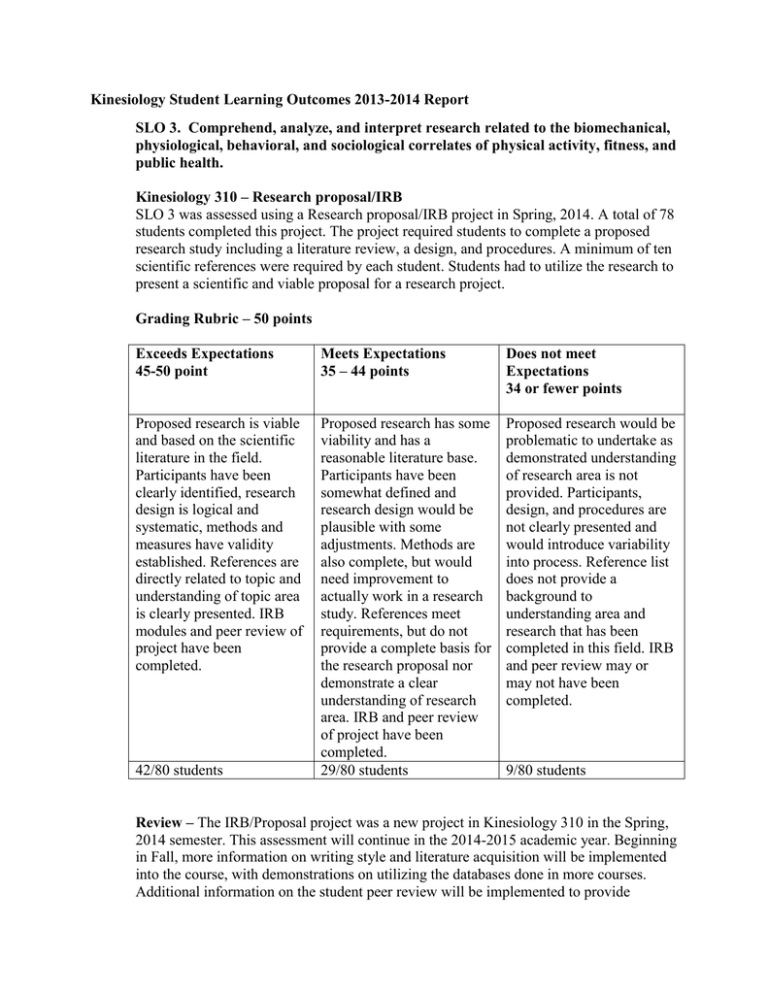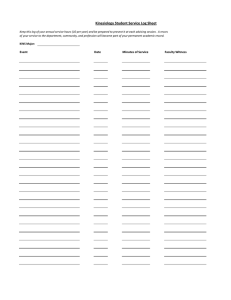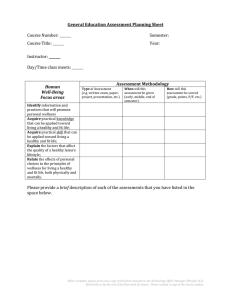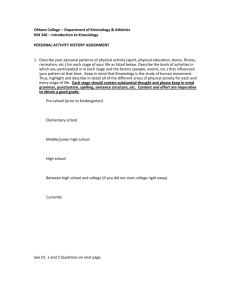Kinesiology Student Learning Outcomes 2013-2014 Report
advertisement

Kinesiology Student Learning Outcomes 2013-2014 Report SLO 3. Comprehend, analyze, and interpret research related to the biomechanical, physiological, behavioral, and sociological correlates of physical activity, fitness, and public health. Kinesiology 310 – Research proposal/IRB SLO 3 was assessed using a Research proposal/IRB project in Spring, 2014. A total of 78 students completed this project. The project required students to complete a proposed research study including a literature review, a design, and procedures. A minimum of ten scientific references were required by each student. Students had to utilize the research to present a scientific and viable proposal for a research project. Grading Rubric – 50 points Exceeds Expectations 45-50 point Meets Expectations 35 – 44 points Does not meet Expectations 34 or fewer points Proposed research is viable and based on the scientific literature in the field. Participants have been clearly identified, research design is logical and systematic, methods and measures have validity established. References are directly related to topic and understanding of topic area is clearly presented. IRB modules and peer review of project have been completed. Proposed research has some viability and has a reasonable literature base. Participants have been somewhat defined and research design would be plausible with some adjustments. Methods are also complete, but would need improvement to actually work in a research study. References meet requirements, but do not provide a complete basis for the research proposal nor demonstrate a clear understanding of research area. IRB and peer review of project have been completed. 29/80 students Proposed research would be problematic to undertake as demonstrated understanding of research area is not provided. Participants, design, and procedures are not clearly presented and would introduce variability into process. Reference list does not provide a background to understanding area and research that has been completed in this field. IRB and peer review may or may not have been completed. 42/80 students 9/80 students Review – The IRB/Proposal project was a new project in Kinesiology 310 in the Spring, 2014 semester. This assessment will continue in the 2014-2015 academic year. Beginning in Fall, more information on writing style and literature acquisition will be implemented into the course, with demonstrations on utilizing the databases done in more courses. Additional information on the student peer review will be implemented to provide students with additional feedback to make the proposal more scientific. The majority of students who did not meet expectations either were not involved in the peer review, did not complete the IRB modules, or did not meet the requirements outlined in the proposal. This project requires a reasonable investment of time in searching for a literature base for the proposed project. Students are allowed to select a topic of interest to increase intrinsic motivation to learn more on the topic, but some students did not put forth adequate time investment to have a reasonable outcome. The majority of students did invest time and put forth a viable research proposal that could eventually be implemented. SLO 7. Retrieve and manage information effectively in the examination and communication of problems and issues related to physical activity, fitness, and public health. Kinesiology 336 – Final Exam To retrieve and manage information effectively in the examination and communication of problems and issues related to physical activity, fitness, and public health. The KIN 336 Final Exam was used to determine if this Student Learning Objective was met. The final exam was made up multiple choice, fill in the blank, and short answer questions. The topics that the students were expected to retrieve on the exam included calibration, blood pressure during exercise, resting metabolic rate, pulmonary function, oxygen uptake, energy expenditure, estimation of submaximal oxygen consumption, determining maximal oxygen uptake, and estimation of the work of the heart. The final exam was worth 60 points of the students’ final grade. A total of 190 students completed the final exam in lab in the Fall and Spring semester 2013-2014. Grading Rubric- Kin 336 final exam Exemplary 54 – 60 points 108/190 students Meeting requirements 42 - 53 points 79/190 student Not meeting requirements 41 or fewer points 3/190 students Review – Students were assessed in the lab final in both the Fall and Spring semesters with the majority of students meeting an exemplary status. The success of these students can be partially attributed to the structure of the 336 lab. Students are in a smaller class setting with more instructor interaction. Students often form a positive relationship with peers and will interact both in and outside the classroom. Students not meeting requirements were more likely to miss lab sessions and less likely to seek out assistance from the instructors. Kinesiology 346 – Lab final project This assignment was designed to allow students to retrieve and manage information in order to complete a paper around the question “Are people responsible for their physical activity behavior”. The primary purpose of the paper is to summarize the scientific evidence identifying the factors that influence an individual’s physical activity. Four drafts of the paper were collected during the semester. Grading Rubric Final Paper – Grammar, spelling, and overall design Introduction Social factors section Policy/Community section Institutional section Interpersonal section Intrapersonal section Conclusion 2 pts 1 pt 1 pt 1 pt 1 pt 1 pt 1 pt 3 pts Final Student performance Exceeds Expectations 9.9 to 11 points 26/88 Meets Expectations 7.7 to 9.8 points 59/88 Does not meet Expectations 7.6 points or fewer 3/88 Review – The lab final project paper was implemented in the Kinesiology 345 lab in the Spring, 2014 semester. The lab paper was 11% of the grade in the lab. During the course of the semester, students turned in 4 drafts of the papers and were provided feedback from the instructors of the labs. This time investment from the instructors assisted the majority of students in the lab in meeting the expectations of the paper. To improve performance, the Writing Center will be presenting in the lab to give additional information on writing styles for this type of document. The writing lab will also be promoted more in class, and students will have more direct access to the writing lab for assistance with the paper. Kinesiology Student Learning Outcomes 2013-2014 Report Student learning outcomes were assessed in three Kinesiology courses during the 2013-2014 academic year. All 8 of the Kinesiology Student Learning Outcomes were assessed over a three year period from 2011-2014. SLO 3 - Comprehend, analyze, and interpret research related to the biomechanical, physiological, behavioral, and sociological correlates of physical activity, fitness, and public health was assessed in Kinesiology through an IRB/Proposal project completed in the Spring, 2014 semester. Although this was a new project, a total of 89% of students either exceeded or met expectations on this project. This assessment will continue in the 2014-2015 academic year with an increased focus on the acquisition and interpretation of scientific literature. SLO-7- Retrieve and manage information effectively in the examination and communication of problems and issues related to physical activity, fitness, and public health was assessed in two courses in the 2014-2015 academic year. This SLO was assessed in lab courses Kin 336 and 346. In Kin 336, the assessment was the final lab exam. During the Fall/Spring semester, a total of 190 students completed the exam with 187 of the 190 either meeting requirements or exemplary in performance. The assessment of SLO 7 in the Kinesiology 345 lab was a paper around the topic “Are people responsible for their physical activity paper.” Students were required to submit 4 drafts of the paper with the final paper worth 11% of the grade in the class. Of the 88 students completing the paper, a total of 85 of the students met or exceeded expectations.


